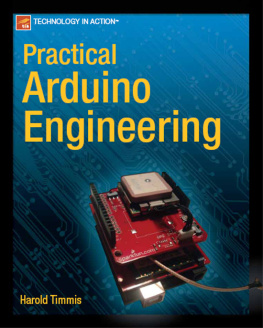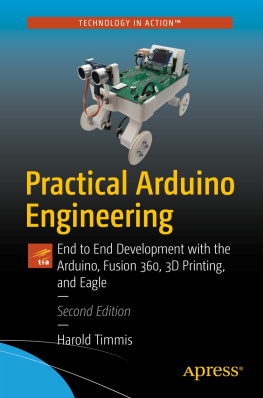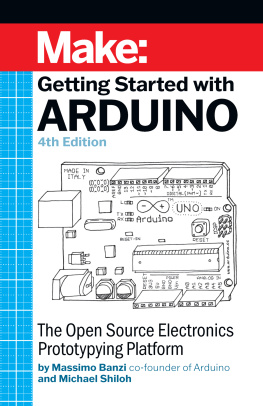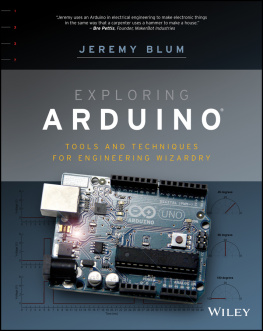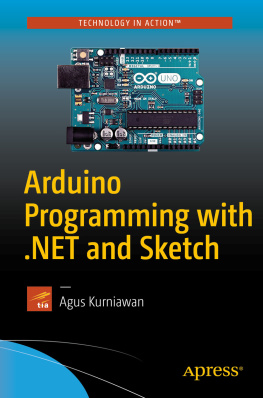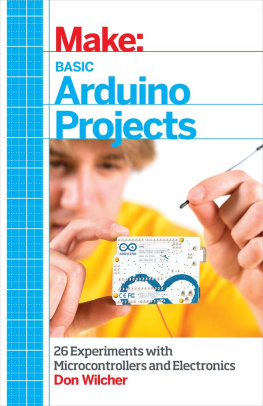Practical Arduino Engineering
Copyright 2011 by Harold Timmis
All rights reserved. No part of this work may be reproduced or transmitted in any form or by any means, electronic or mechanical, including photocopying, recording, or by any information storage or retrieval system, without the prior written permission of the copyright owner and the publisher.
ISBN-13 (pbk): 978-1-4302-3885-0
ISBN-13 (electronic): 978-1-4302-3886-7
Trademarked names, logos, and images may appear in this book. Rather than use a trademark symbol with every occurrence of a trademarked name, logo, or image we use the names, logos, and images only in an editorial fashion and to the benefit of the trademark owner, with no intention of infringement of the trademark. The use in this publication of trade names, trademarks, service marks, and similar terms, even if they are not identified as such, is not to be taken as an expression of opinion as to whether or not they are subject to proprietary rights. Practical Arduino Engineering is an independent publication and is not affiliated with, nor has it been authorized, sponsored, or otherwise approved by Microsoft Corporation. LabVIEW is a trademark of National Instruments. This publication is independent of National Instruments, which is not affiliated with the publisher or the author, and does not authorize, sponsor, endorse or otherwise approve this publication.
President and Publisher: Paul Manning
Lead Editor: James Markham
Technical Reviewers: Andreas Wischer, Coleman Sellers
Editorial Board: Steve Anglin, Mark Beckner, Ewan Buckingham, Gary Cornell, Morgan Engel, Jonathan
Gennick, Jonathan Hassell, Robert Hutchinson, Michelle Lowman, James Markham, Matthew Moodie,
Jeff Olson, Jeffrey Pepper, Douglas Pundick, Ben Renow-Clarke, Dominic Shakeshaft, Gwenan
Spearing, Matt Wade, Tom Welsh
Coordinating Editor: Corbin Collins
Copy Editors: Heather Lang, Tracy Brown, Vanessa Moore, Tiffany Taylor
Compositor: Bytheway Publishing Services
Indexer: SPI Global
Artist: SPI Global
Cover Designer: Anna Ishchenko
Distributed to the book trade worldwide by Springer Science+Business Media, LLC., 233 Spring Street, 6th Floor, New York, NY 10013. Phone 1-800-SPRINGER, fax (201) 348-4505, e-mail orders-ny@springer-sbm.com, or visit www.springeronline.com.
For information on translations, please e-mail rights@apress.com, or visit www.apress.com.
Apress and friends of ED books may be purchased in bulk for academic, corporate, or promotional use. eBook versions and licenses are also available for most titles. For more information, reference our Special Bulk SaleseBook Licensing web page at www.apress.com/bulk-sales.
The information in this book is distributed on an as is basis, without warranty. Although every precaution has been taken in the preparation of this work, neither the author(s) nor Apress shall have any liability to any person or entity with respect to any loss or damage caused or alleged to be caused directly or indirectly by the information contained in this work.
The source code for this book is available to readers at www.apress.com. You will need to answer questions pertaining to this book in order to successfully download the code.
To my wife and my family because you are all always there for me.
Contents at a Glance

















Contents
















About the Author
 Harold Timmis, since he was a small child, has fostered a curiosity for technology, taking apart everything in his parents' house just to see how it all worked. This fueled his thirst for knowledge of computer science, programming, and its uses. He has worked with LabVIEW and Arduino for the past three years. During that time, he has been involved in several professional projects using LabVIEW, as well as many hobbyist projects utilizing both Arduino and LabVIEW. Harold attended the Florida Institute of Technology, where he studied computer engineering and was introduced to LabVIEW and Arduino. Later, he worked at the Harris Corporation and General Electric, where he created several LabVIEW projects for trains and became very interested in the Arduino, data acquisition, and control theory.
Harold Timmis, since he was a small child, has fostered a curiosity for technology, taking apart everything in his parents' house just to see how it all worked. This fueled his thirst for knowledge of computer science, programming, and its uses. He has worked with LabVIEW and Arduino for the past three years. During that time, he has been involved in several professional projects using LabVIEW, as well as many hobbyist projects utilizing both Arduino and LabVIEW. Harold attended the Florida Institute of Technology, where he studied computer engineering and was introduced to LabVIEW and Arduino. Later, he worked at the Harris Corporation and General Electric, where he created several LabVIEW projects for trains and became very interested in the Arduino, data acquisition, and control theory.
About the Technical Reviewers
 Andreas Wischer holds a German degree in electronics. Since 1997 he has worked as a software consultant across Europe. With a solid background in expert systems and C programming, he now spends most of his working time on Java and Lotus Notes. For the latter he's certified for both development and administration.
Andreas Wischer holds a German degree in electronics. Since 1997 he has worked as a software consultant across Europe. With a solid background in expert systems and C programming, he now spends most of his working time on Java and Lotus Notes. For the latter he's certified for both development and administration.

